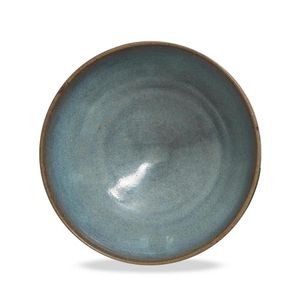Korean Celadon Bowl, Yi Dynasty, 14th-15th Century
You must be a subscriber, and be logged in to view price and dealer details.
Subscribe Now to view actual auction price for this item
When you subscribe, you have the option of setting the currency in which to display prices to $Au, $US, $NZ or Stg.
- Crackling and Crackle as a Decorative Technique - Crackle, also known as crackling, is a decorative technique that has been used in China for centuries. It is believed to have originated during the Song Dynasty (960?1279 AD) and was primarily used in the production of ceramics, lacquerware, and furniture. The crackling effect was achieved by applying a glaze or lacquer that was formulated to crack during firing, creating a crackled pattern on the surface of the item.
During the Ming Dynasty (1368?1644 AD), crackle became a highly sought-after decorative technique, and it was used to create intricate and beautiful designs on ceramics and lacquer ware.
In Western decorative arts, crackle / crackling came into use during the Art Nouveau movement in the late 19th and early 20th century. The crackling effect was used to create a sense of movement and fluidity in the design of Art Nouveau pieces.
It was also used in the 1920s and 1930s during the Art Deco movement. - Ming Dynasty - The Ming Dynasty was a ruling dynasty of China from 1368 to 1644. It succeeded the Yuan Dynasty and preceded the Qing Dynasty. The Ming Dynasty was established by Zhu Yuanzhang, a former Buddhist monk who became a rebel leader and eventually overthrew the Mongol Yuan Dynasty. During the Ming Dynasty, China experienced a period of relative stability and prosperity. The government was centralized and bureaucratic, with the emperor at the top of the hierarchy. The Ming Dynasty is known for its cultural achievements, including the development of porcelain, the invention of movable type printing, and the construction of the Great Wall of China.
- Crackles / Cracquelure - In ceramics, crackles may be introduced intentionally during the firing process, as was often the case with Oriental ceramics, and are known as artificial crackles. Natural crackles occur with age, and if the glaze is transparent, may be difficult to detect. Natural crackles may not cover the whole surface of the object and may be uneven in size.
This item has been included into following indexes:
Visually similar items

A large Longquan charger with impressed floral spray in the interior centre, surrounded by freely executed cloud like motifs on the cavetto surmounted by a band of four horizontal lines, covered in a pale olive green celadon glaze, except for the burned or

A Longquan celadon bowl in grey/green glaze, Song Dynasty (960-1279), 13 cm diameter. Provenance: Sotheby's Australia, The Estate of the Late John Kenny, 17/18 May 2004, Lot 6, Sydney Moss Ltd. London

A good Jun ware bowl, Yuan dynasty covered with a bright milky-blue glaze, darkening at the mouth rim, 8.2 cm high, 8.8 cm diameter

A Yaozhou celadon bowl, Song dynasty (960-1279), 12th century, carved and combed decoration, 5 cm high, 13 cm diameter. Provenance: Kenny Chong, Hong Kong, 1982
